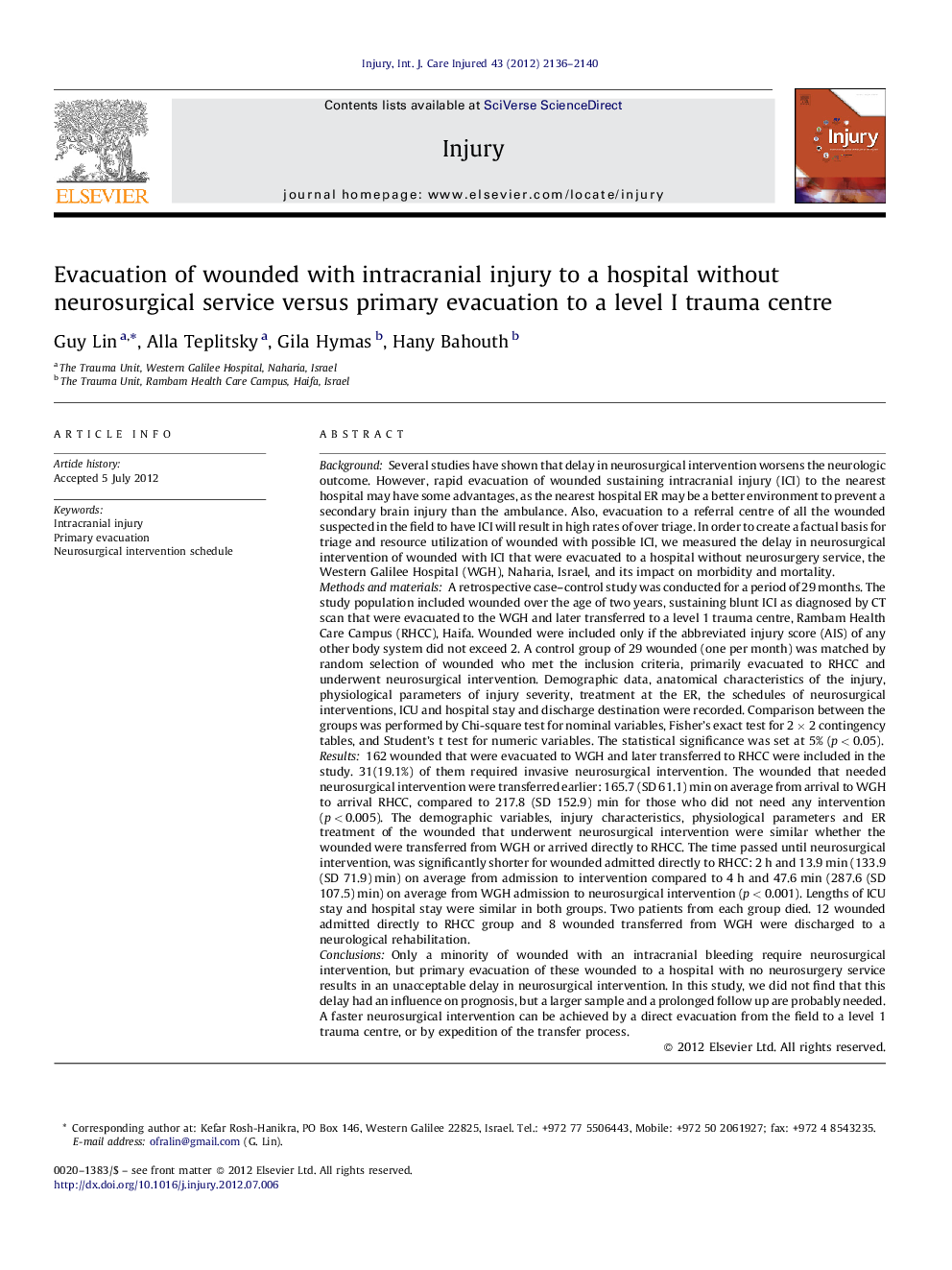| کد مقاله | کد نشریه | سال انتشار | مقاله انگلیسی | نسخه تمام متن |
|---|---|---|---|---|
| 3240705 | 1206050 | 2012 | 5 صفحه PDF | دانلود رایگان |

BackgroundSeveral studies have shown that delay in neurosurgical intervention worsens the neurologic outcome. However, rapid evacuation of wounded sustaining intracranial injury (ICI) to the nearest hospital may have some advantages, as the nearest hospital ER may be a better environment to prevent a secondary brain injury than the ambulance. Also, evacuation to a referral centre of all the wounded suspected in the field to have ICI will result in high rates of over triage. In order to create a factual basis for triage and resource utilization of wounded with possible ICI, we measured the delay in neurosurgical intervention of wounded with ICI that were evacuated to a hospital without neurosurgery service, the Western Galilee Hospital (WGH), Naharia, Israel, and its impact on morbidity and mortality.Methods and materialsA retrospective case–control study was conducted for a period of 29 months. The study population included wounded over the age of two years, sustaining blunt ICI as diagnosed by CT scan that were evacuated to the WGH and later transferred to a level 1 trauma centre, Rambam Health Care Campus (RHCC), Haifa. Wounded were included only if the abbreviated injury score (AIS) of any other body system did not exceed 2. A control group of 29 wounded (one per month) was matched by random selection of wounded who met the inclusion criteria, primarily evacuated to RHCC and underwent neurosurgical intervention. Demographic data, anatomical characteristics of the injury, physiological parameters of injury severity, treatment at the ER, the schedules of neurosurgical interventions, ICU and hospital stay and discharge destination were recorded. Comparison between the groups was performed by Chi-square test for nominal variables, Fisher's exact test for 2 × 2 contingency tables, and Student's t test for numeric variables. The statistical significance was set at 5% (p < 0.05).Results162 wounded that were evacuated to WGH and later transferred to RHCC were included in the study. 31(19.1%) of them required invasive neurosurgical intervention. The wounded that needed neurosurgical intervention were transferred earlier: 165.7 (SD 61.1) min on average from arrival to WGH to arrival RHCC, compared to 217.8 (SD 152.9) min for those who did not need any intervention (p < 0.005). The demographic variables, injury characteristics, physiological parameters and ER treatment of the wounded that underwent neurosurgical intervention were similar whether the wounded were transferred from WGH or arrived directly to RHCC. The time passed until neurosurgical intervention, was significantly shorter for wounded admitted directly to RHCC: 2 h and 13.9 min (133.9 (SD 71.9) min) on average from admission to intervention compared to 4 h and 47.6 min (287.6 (SD 107.5) min) on average from WGH admission to neurosurgical intervention (p < 0.001). Lengths of ICU stay and hospital stay were similar in both groups. Two patients from each group died. 12 wounded admitted directly to RHCC group and 8 wounded transferred from WGH were discharged to a neurological rehabilitation.ConclusionsOnly a minority of wounded with an intracranial bleeding require neurosurgical intervention, but primary evacuation of these wounded to a hospital with no neurosurgery service results in an unacceptable delay in neurosurgical intervention. In this study, we did not find that this delay had an influence on prognosis, but a larger sample and a prolonged follow up are probably needed. A faster neurosurgical intervention can be achieved by a direct evacuation from the field to a level 1 trauma centre, or by expedition of the transfer process.
Journal: Injury - Volume 43, Issue 12, December 2012, Pages 2136–2140